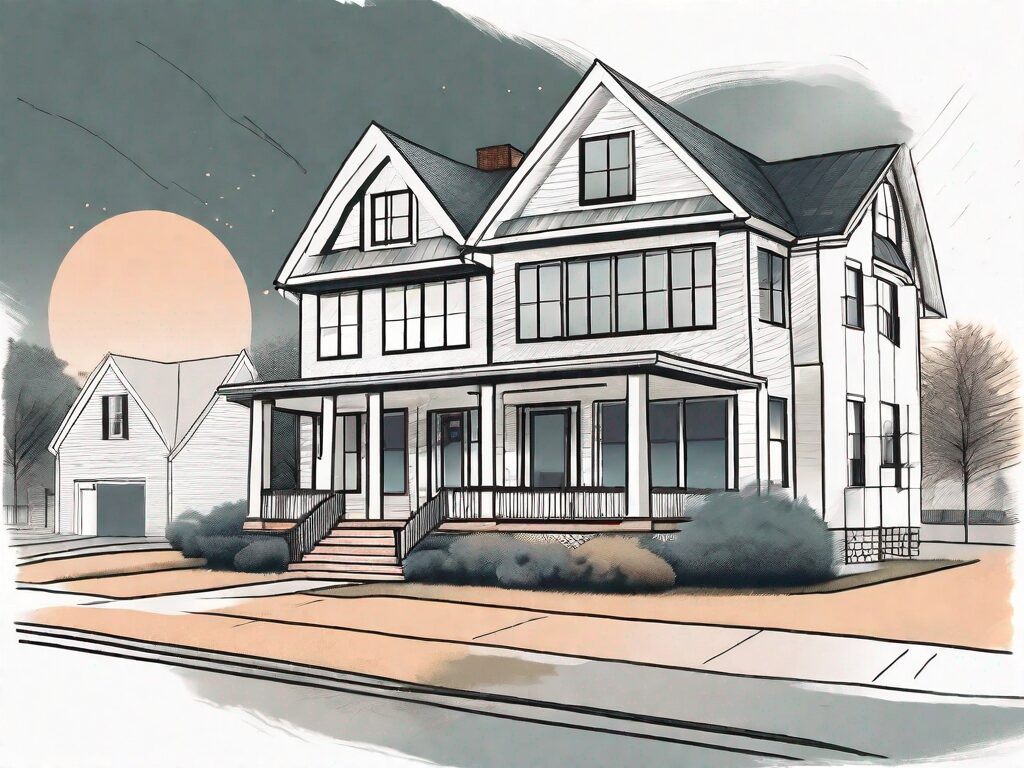
Agent A-Team or Solo Superhero? Finding the Right Real Estate Partner for Your Selling Journey in Wildwood Florida
When it comes to selling your home in Wildwood, Florida,…
January 29, 2024
In recent years, house flipping has become a popular strategy for real estate investors to generate substantial profits. If you’re considering venturing into this lucrative endeavor in Buffalo, NY, you’ve come to the right place. This comprehensive guide will equip you with the knowledge and insights needed to successfully flip houses in this thriving city. So, let’s dive in and explore the fascinating world of house flipping.
House flipping involves purchasing a property, renovating it, and then selling it at a higher price to make a profit. This strategy requires careful planning, extensive market research, and a solid understanding of the real estate industry.
One of the key advantages of house flipping is the potential for quick returns. By investing time and resources into renovating a property, you can significantly increase its market value, allowing for a profitable resale.
When it comes to house flipping, the first step is to identify properties that have the potential for profitable renovations. This requires a keen eye for detail and a deep understanding of the local real estate market. You need to consider factors such as location, neighborhood trends, and the condition of the property.
Once you have found a property with potential, the next step is to create a detailed renovation plan. This plan should outline the scope of work, estimated costs, and a timeline for completion. It’s crucial to carefully budget your expenses and ensure that the renovations will add significant value to the property.
Managing contractors is another important aspect of house flipping. You need to find reliable and skilled professionals who can complete the renovations within the agreed-upon timeframe and budget. Communication is key in this process, as you will need to oversee the progress of the renovations and address any issues that may arise.
After the renovations are complete, it’s time to market the property for sale. This involves creating an enticing listing that highlights the property’s features and improvements. Professional photography and staging can greatly enhance the appeal of the property and attract potential buyers.
House flipping can be a profitable venture, but it’s important to be aware of the risks involved. The real estate market can be unpredictable, and there is always a chance that you may not be able to sell the property for the desired price or within the expected timeframe. It’s crucial to have a backup plan and be prepared for any unexpected challenges that may arise.
In conclusion, house flipping can be a lucrative investment strategy for those who are willing to put in the time, effort, and research required. By carefully selecting properties, planning renovations, and effectively managing the process, you can increase the market value of a property and make a profit upon resale. However, it’s important to approach house flipping with caution and be prepared for potential risks and challenges along the way.
Buffalo, NY, offers great opportunities for aspiring house flippers. The city has experienced impressive economic growth in recent years, leading to increased demand for quality housing. This creates a ripe market for investors looking to buy homes, renovate them, and turn a profit.
Buffalo’s real estate market has seen a significant transformation in recent times. The city’s revitalization efforts have breathed new life into once-neglected neighborhoods, attracting both residents and businesses. As a result, property values have been steadily increasing, making it an ideal time to invest in house flipping.
One of the key factors contributing to the profitability of flipping houses in Buffalo is the city’s affordability. Compared to larger metropolitan areas like New York City or San Francisco, Buffalo offers much lower property prices. This affordability allows investors to purchase properties at a lower cost, increasing the potential for higher returns on investment.
Moreover, Buffalo’s improving job market is another driving force behind the city’s house flipping success. The region has seen a surge in job opportunities, particularly in sectors such as healthcare, education, and advanced manufacturing. This influx of jobs has not only increased the demand for housing but also improved the overall economic stability of the city.
When considering flipping houses in Buffalo, it is essential to analyze the local market conditions and trends. Conducting thorough research on the neighborhoods, property values, and market demand will help you make informed investment decisions. Understanding the demographics of the area, such as the target market for potential buyers, can also guide your renovation choices and marketing strategies.
Another advantage of flipping houses in Buffalo is the availability of resources and support for investors. The city has various programs and incentives aimed at revitalizing neighborhoods and promoting homeownership. These initiatives can provide financial assistance, tax incentives, or even access to professional networks, making it easier for investors to navigate the house flipping process.
Furthermore, Buffalo’s rich history and architectural heritage offer unique opportunities for house flippers. Many properties in the city boast stunning architectural features, such as Victorian-era homes or Art Deco buildings. Preserving and restoring these historical elements can add significant value to a flipped property, attracting buyers who appreciate the charm and character of older homes.
In conclusion, the profitability of flipping houses in Buffalo, NY, is evident due to the city’s economic growth, affordability, improving job market, and various resources available to investors. By carefully analyzing the local market conditions and leveraging the unique opportunities the city offers, aspiring house flippers can find success in Buffalo’s thriving real estate market.
Buffalo, a city known for its rich history and vibrant culture, offers a unique opportunity for aspiring real estate investors to dive into the world of house flipping. With its diverse neighborhoods and a growing demand for quality housing, Buffalo presents both advantages and challenges for those looking to make a profit in the real estate market.
Flipping houses in Buffalo comes with a plethora of advantages that make it an enticing venture for many. Firstly, it can provide an excellent source of income, allowing you to generate substantial profits in a relatively short period of time. With careful planning and strategic decision-making, you can turn a neglected property into a lucrative investment.
Moreover, house flipping allows for creativity and personalization. Buffalo is a city with a rich architectural heritage, and by renovating and restoring houses, you have the opportunity to transform run-down properties into beautiful and functional homes that buyers will be eager to purchase. Whether it’s preserving the original charm or adding modern touches, your creative vision can shine through in each project.
Additionally, successful house flips can enhance your reputation and establish your credibility in the real estate market. Buffalo has a tight-knit community of investors and professionals who appreciate quality work. By delivering exceptional results, you can build a strong network and gain recognition, opening doors to future investment opportunities and partnerships.
While house flipping in Buffalo offers enticing advantages, it’s essential to consider the potential drawbacks and challenges associated with this endeavor. One of the main challenges is the risk of unexpected costs and delays during the renovation process. Buffalo’s older housing stock may require extensive repairs and updates, which can lead to unforeseen expenses. It’s crucial to set realistic budgets and have contingency plans in place to mitigate these risks effectively.
Furthermore, house flipping requires a significant investment of time and effort. From searching for suitable properties to managing contractors and overseeing renovations, this process demands dedication and attention to detail. However, the rewards can be worth it, as each successful flip adds to your experience and expertise in the field.
Market volatility is another factor to consider when flipping houses in Buffalo. Like any real estate market, fluctuations in property values and demand can impact your potential returns and overall profitability. Staying informed about market trends and conducting thorough market research can help you make informed decisions and minimize risks.
In conclusion, flipping houses in Buffalo offers a promising opportunity for real estate investors. With its unique advantages and challenges, it’s crucial to carefully weigh the pros and cons before diving into this endeavor. By understanding the market, being prepared for unexpected obstacles, and leveraging your creativity, you can navigate the world of house flipping in Buffalo and potentially reap significant rewards.
House flipping has become a popular investment strategy in recent years, offering the potential for substantial profits. If you’re considering entering the world of house flipping in Buffalo, it’s essential to arm yourself with expert tips and strategies to increase your chances of success. In this article, we will explore key factors to consider when choosing a house to flip, essential steps for a successful flip, financing options, and how to maximize profits when selling your flipped house.
When it comes to house flipping, not all properties are created equal. The success of your endeavor largely depends on the properties you choose to invest in. While there are many factors to consider, three key factors stand out: location, potential resale value, and renovation requirements.
Location plays a crucial role in determining the profitability of a house flip. Look for neighborhoods with high demand and increasing property values. This will enhance your chances of selling the flipped house at a profit. Additionally, consider the proximity to amenities such as schools, parks, and shopping centers, as these factors can greatly influence a buyer’s decision.
Potential resale value is another important consideration. Research recent sales in the area to get an idea of what similar properties are selling for. This will help you determine if there is enough profit potential to make the investment worthwhile.
Lastly, evaluate the renovation requirements of the property. Take into account the cost and complexity of the necessary renovations. It’s important to strike a balance between properties that require significant work and those that can be renovated within a reasonable budget and timeframe.
Once you’ve identified a promising property, it’s time to dive into the essential steps for a successful house flip. These steps will help you stay organized, make informed decisions, and avoid costly mistakes.
Start by creating a detailed business plan that outlines your goals, budget, timeline, and target buyer profile. This will serve as your roadmap throughout the flipping process and help you stay focused on your objectives.
Thoroughly research the local real estate market to gain insights into current trends and buyer preferences. Understanding what buyers are looking for will inform your property acquisition strategy and renovations. For example, if families are in high demand, consider adding features such as a backyard or extra bedrooms to attract this demographic.
Develop a reliable network of contractors and vendors who can deliver quality work within your budget and desired timeframe. Effective project management is crucial to avoiding delays and cost overruns. Get multiple quotes for each renovation project and carefully vet each contractor to ensure they have the necessary experience and expertise.
Throughout the renovation process, regularly evaluate your progress against your business plan. Make adjustments as needed to stay on track and within budget. Keep in mind that unexpected challenges may arise, so it’s important to have contingency plans in place.
Securing appropriate financing is vital for the success of your house flipping venture. Traditional mortgage options may not be suitable for this type of investment, so it’s important to explore alternative financing options.
One popular option is a hard money loan, which is a short-term loan secured by the property you’re flipping. These loans typically have higher interest rates but offer more flexibility and faster approval processes compared to traditional loans.
Private investors or partnerships are another financing option to consider. These individuals or groups provide the necessary capital to purchase and renovate the property in exchange for a share of the profits. It’s essential to carefully consider the terms and interest rates associated with these financing options to ensure they align with your goals and budget.
The final stage of a successful house flip is selling the property for a profit. To maximize your returns, it’s important to ensure that your renovated home appeals to potential buyers.
Consider factors such as location, curb appeal, staging, and pricing strategies. Location plays a significant role in attracting buyers, so highlight any desirable features of the neighborhood in your marketing materials.
Curb appeal is another crucial aspect to consider. First impressions matter, so invest in landscaping, fresh paint, and other exterior improvements to make your property stand out. Additionally, stage the interior to showcase the home’s potential and help buyers envision themselves living there.
Pricing your flipped house strategically is key to attracting buyers while maximizing your profits. Research recent sales in the area and consult with a knowledgeable real estate agent to determine the optimal listing price. Pricing too high can deter potential buyers, while pricing too low may leave money on the table.
Working with a knowledgeable real estate agent can help you navigate the selling process and attract the right buyers. They can provide valuable insights into the local market, assist with marketing and negotiations, and help you achieve the best possible sale price.
By considering these expert tips and implementing them into your house flipping strategy, you’ll be well on your way to mastering the art of house flipping in Buffalo. Remember, success in house flipping requires careful planning, thorough research, and a commitment to delivering a quality product that meets the needs and desires of potential buyers.
Before starting a house flip, it’s crucial to have a thorough understanding of the financial aspects involved. Expenses include the purchase price, renovation costs, holding costs (such as property taxes and insurance), and selling costs.
Calculating a realistic budget and diligently tracking expenses throughout the renovation process will ensure that you stay within your financial limits and protect your potential profits.
House flipping requires a significant time commitment. From property searching to overseeing renovations and managing the selling process, being proactive and efficient with your time is essential.
Having a clear timeline and project plan in place will help you stay organized and meet your project goals within your desired timeframe.
Flipping houses without any upfront capital is an enticing idea for many aspiring investors. While it may be possible, it requires creative thinking and careful planning.
Exploring partnerships, securing private loans, or using creative financing strategies, such as wholesaling, are potential options for obtaining funding without personal capital. However, it’s crucial to fully understand the associated risks and challenges.
The duration of a house flip can vary depending on factors such as the extent of renovations, market conditions, and unforeseen challenges that may arise during the process.
On average, a house flip can take anywhere from a few months to a year. Setting realistic expectations and having a contingency plan for unexpected delays will help you navigate the process effectively.
Embarking on a house flip without proper knowledge and preparation can lead to costly mistakes and potential financial losses.
Some common mistakes include underestimating renovation costs, lacking a comprehensive understanding of the local market, overpricing the property, and failing to conduct thorough due diligence.
Learning from experienced house flippers, consulting professionals, and continually educating yourself on industry best practices will help minimize these mistakes and increase your chances of success.
While house flipping in Buffalo, NY, can be a lucrative endeavor, it’s crucial to assess your personal skills, resources, and risk tolerance before diving in.
Careful market analysis, realistic budgeting, effective project management, and a strong understanding of real estate fundamentals are key to determining whether the potential returns align with your investment goals.
Flipping houses with no money in Buffalo, NY, requires a combination of creativity and determination.
Some strategies include forming partnerships with individuals or organizations that can provide the necessary capital, leveraging your existing assets as collateral, or exploring financing options tailored for house flipping ventures.
It’s important to conduct thorough research, network with industry professionals, and have a solid understanding of the local market to implement these strategies effectively.
With this ultimate guide, you’re now equipped with the knowledge and insights needed to embark on a successful house flipping journey in Buffalo, NY. Remember to approach each opportunity with diligence, adapt to market conditions, and continuously refine your skills to maximize your chances of success. Happy house flipping!

If you want the Richr team to help you save thousands on your home just book a call.
 Book a call
Book a call